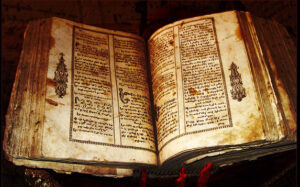Evidence from history suggests that humans have always been fascinated by mysticism, magic, enlightenment, and other supernatural phenomena. There are several historical texts that were once seen as the key to harnessing these powers, some of which will be represented here:
Liber Juratus
The ‘Sworn Book of Honorius‘ is a medieval grimoire to which Honorius of Thebes has been given credit. It is one of the oldest and influential books of magic of its day.

The Liber Juratus has strict rules associated with it. According to the text, no more than three copies of the book can be made, and one must take it to their grave if a suitable magician cannot be found to inherit it. The company of women is also forbidden to its practitioners.
The rituals outlined within focus on summoning spirits, demons and angels who might teach the practitioner their knowledge. Many supernatural powers are promised to those who repeat the lengthy spells, such as knowledge of one’s date of death, and the ability to cause floods, sickness, discord and death.
Picatrix
 Originally written in Arabic with the title Gh?yat al-?ak?mh, the Picatrix is an 11th century periodical containing 400 pages of astrological magic and theory.
Originally written in Arabic with the title Gh?yat al-?ak?mh, the Picatrix is an 11th century periodical containing 400 pages of astrological magic and theory.
It is infamous for its magical potion recipes, which include such gruesome ingredients as brain matter, blood, sperm, ear wax, feces, urine as well as psychoactive plants such as opium and hashish.
For their trouble, the brave adherent might expect to achieve such powers as the ability to channel energy from the planets and resurrect your own zombie army.
Papyri Graecae Magicae
 The Greek Magical Papyri are a series of texts from 2nd century BC to 5th century AD Greco-Roman Egypt, the best known of which is the Mithras Liturgy, which outlines the mystic ascent of the soul through seven stages, or grades, and how to communicate with the god Mithras.
The Greek Magical Papyri are a series of texts from 2nd century BC to 5th century AD Greco-Roman Egypt, the best known of which is the Mithras Liturgy, which outlines the mystic ascent of the soul through seven stages, or grades, and how to communicate with the god Mithras.
Perhaps the most common spells of these works are for visions of the future, one of the most well-known of which purports to forecast near-future events using an ‘iron lampstead,’ frankincense and an ‘uncorrupted and pure’ child. Otherwise included are summoning spells, instructions for opening paths to the underworld, and how one might gain the assistance of a spiritual entity.[shareaholic app=”share_buttons” id=”5111567″]
Galdrabok
 The Icelandic Book of Magic is a small collection of 47 spells edited by four different authors between the 16th and 17th centuries. The manuscript was not translated until 1921, into Swedish, and was not translated into English until 1989.
The Icelandic Book of Magic is a small collection of 47 spells edited by four different authors between the 16th and 17th centuries. The manuscript was not translated until 1921, into Swedish, and was not translated into English until 1989.
The power of the magic is derived mainly from Icelandic magical staves, or (simply) runes. Many of the spells within are prophylactic, intended to prevent maladies such as trouble in childbirth, insomnia, headache, pestilence, problems while seafaring, or prior magic. There are also spells of aggression, outlining how the mystic might incite fear, kill animals, catch thieves, or cause flatulence, drowsiness and bewitchment in others.
The Pseudomonarchia Daedonum
The Hierarchy of Demons is attributed to Johann Weyer, an influential physician and occultist. it first appears as an appendix to the larger work, Praestigiis Daemonum, which was celebrated by Sigmund Freud as one of the top ten most significant books of all time.
The text catalogs 69 demons of hell’s hierarchy, what they do, and how to conjure and employ them. Weyer was a devout Christian and therefore quite cautionary about utilizing these demons, even omitting details in the rituals. However, an enterprising magician might be able to decipher how to use these creatures to assist in such things as improving one’s cunning, finding lost treasures, turning water into wine, or seeing the future.












